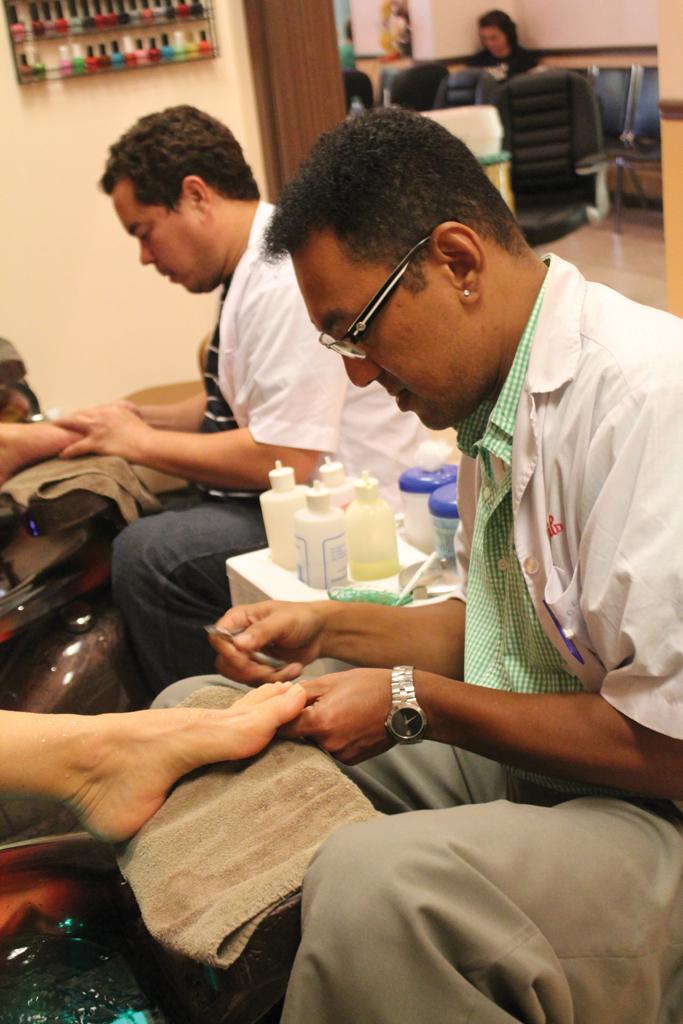
A typical nail salon visit involves plenty of acetone, a nail file and a couple coats of some trendy candy apple red.
But while a manicure can be an easy way to relax after a stressful day, the worries of the manicurist on the other side of the table may not be as easily remedied.
Some had jobs as scientists or lawyers in their home country. Others come to the United States with little more than the shirt on their backs.
Minh Nguyen, 40, the manager of Nail Trix in the Oakdale Mall, immigrated to the United States from Vietnam with his mother and brother when he was 18.
“Nobody was hiring in Vietnam,” Nguyen said. “It was very poor over there.”
He arrived in Syracuse, where he worked in a factory making parts for televisions.
“In the factory we had to work for four hours straight and only got a 15-minute break before going back to work,” Nguyen said. “And the supervisor was always watching.”
Nguyen was soon encouraged by his girlfriend to enter the nail business.
With the help of his father, who ran a nail salon in Syracuse, Nguyen got his current job at Nail Trix and he has been there for about 10 years.
According to the Office of National Statistics, certain ethnic groups tend to gather in particular industries when they immigrate to the United States.
For example, statistics from 2004 show that three-fifths of Bangladeshi men and just less than half of Chinese men worked in the distribution, hotel and restaurant industry, compared to the just one-sixth of white British immigrants who worked in the same industry. Pakistani men were the group most likely to work in the transport and communication industry — 23 percent of them worked in this sector compared to 10 percent of employed men overall.
Similar statistics hold true in Binghamton.
Andrew Baranoski, executive director of the American Civic Association, said many Vietnamese gather around the nail industry while many Iraqis become cab drivers.
According to Baranoski, it is common for newcomers from a certain country to go into the same field when they come to America.
“It goes back decades,” Baranoski said. “There are the Italians that would come here and work at EJ [the Endicott-Johnson Shoe Company] … So it’s just a continuation of folks from the same backgrounds taking care of one another.”
The ACA is a private, not-for-profit association that has existed in Binghamton since 1939. The community center provides citizenship and language assistance to local immigrants.
Nguyen spent his first two years in America learning English with the help of a local church. Once he became more proficient in English, he went to New York City to take classes on how to do nails.
Nguyen said he fell in love with the trade. He went from making $1 a day in Vietnam, to $4.10 an hour at the factory in Syracuse, to $8 an hour about 10 years ago. Nguyen is now making $10 per hour, a figure that exceeds the expectations he had when he first immigrated here.
“I’m very happy because I can meet a lot of people, and it helps me learn English,” he said.
However, not every immigrant is so lucky. According to Baranoski, employment is one of the greatest challenges an immigrant faces.
“If you were a professional back at your home country and are now stocking shelves at Wal-Mart, that would be a considerable step down in many ways,” he said.
Modesta Lesniewska is a manicurist at Dieci Lifestyle Spa in Livingston, N.J. Before, she was a lab scientist in Poland, where her education included more than lemon and honeysuckle spa treatments. After she immigrated, she needed to adjust from her Polish life to enter the world of polish.
Lesniewska went to the Capri Institute of Cosmetology and the Star Nail Tech Institute. She has now worked at Dieci Lifestyle Spa for most of her 23 years in the beauty industry.
Baranoski said he once helped bring another refugee over from Poland where the man was an attorney, but could only find work digging ditches when he arrived in America.
Jennifer Trinh, a manicurist in San Francisco, was wealthy in Vietnam, but she began working seven days a week at a nail salon to make ends meet after immigrating, according to a 2006 CBS news report.
Trinh said she hopes to go back to school to become a real estate agent.
But for many older immigrants in the U.S., attaining a professional career can take tremendous work, if not prove impossible.
“It can be a slow process to recertification as you have to go back to school and improve language skills in some cases,” Baranoski said. “It’s doable but requires effort and resources.”
However, having to maintain jobs for which they are overqualified can do more than lessen immigrants’ incomes. It can have a difficult emotional impact and make it hard for them to cope with their new life, according to Baranoski.
“I came here and had nothing,” Trinh said. “I accepted the job, but I cry a lot.”
Baranoski said mental health services are available, but often require language assistance, and many never take advantage.
“It’s also hard to raise your hand and say, ‘I’m depressed.’ It’s tough stuff,” he said. “I have the greatest admiration for these people.”


